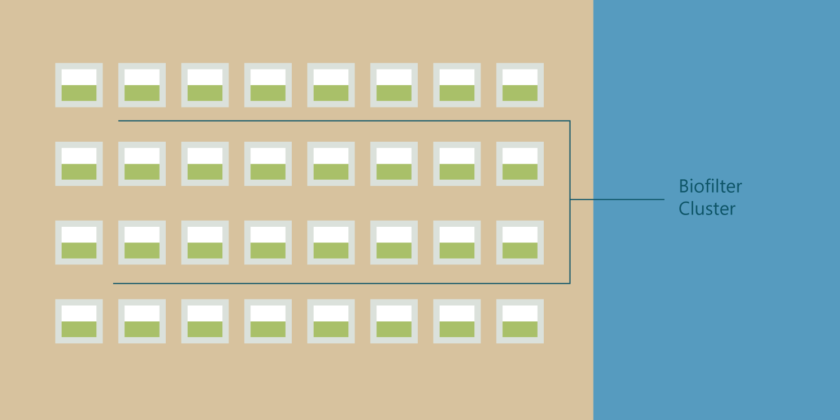Protecting & Restoring Long Island's Peconic Bays

NRBs can be scaled to treat septic tank effluent from multiple residences or businesses. For this BMP, septic tanks provide primary treatment and low-solids effluent is pumped to the cluster treatment system for secondary and tertiary treatment (nitrification and denitrification). This approach is commonly referred to as a Septic Tank Effluent Pumping system or “STEP.” STEP can feed effluent from multiple homes to a cluster NRB. Flow can be equalized so piping can be smaller and shallower, and the cluster treatment system could be sized for steady flows with reduced solids removal by the cluster system.
Although not currently approved by Article 19 of the Suffolk County Sanitary Code, NRB cluster systems would likely need to meet the same siting and setback requirements as I/A OWTS cluster systems.
The following permits would likely be required for installation of cluster NRB systems:
Upon provisional approval, NRB systems will be eligible for the same funding sources available installation of Innovative and Alternative On-Site Wastewater Treatment Systems (I/A OWTS) systems.
The extent of nitrogen removal varies among the different systems, but all approved systems reduce nitrogen to be below the Suffolk County effluent limit of 19 mg/L and the goal for these systems is reduce nitrogen levels to below 10 mg/L (SBU CCWT 2016). The amount of nitrogen removed is influenced by the amount of nitrogen in the influent, the amount of nitrogen that is removed in the sand layer, lower temperatures in the winter, and to a lesser extent, residence time in the biofilters (Gobler et al. 2021).
The influent source for an NRB cluster system is septic tank effluent, with a concentration of 65 mg/L (CDM Smith 2020). TheThe influent source for an NRB cluster system is septic tank effluent, with a concentration of 65 mg/L (CDM Smith 2020). The low and high total nitrogen effluent concentrations, respectively, and are estimated from the average total nitrogen effluent concentrations measured over 16 months from start-up for Suffolk County experimental systems by SBU CCWT (Spring 2018 to Summer 2019; Gobler et al. 2021) and the 2019 average measured by SCDHS (as of December 31, 2019; Suffolk County 2020a)
Cluster NRB Nitrogen Effluent Concentrations, Nitrogen Reduction, and Annual Removal Rates
| Technology | Effluent Nitrogen Concentration (mg/L) | Nitrogen Reduction (%) | Annual Nitrogen Removal (lb/yr) |
|---|---|---|---|
| Cluster NRB | 7.0–9.1 | 86–89 | 2,549–2,644 |
The capital cost for NRB cluster treatment plant is scaled up from individual NRB costs for a 15,000 gpd system and estimated at $541,430. This approach assumes existing septic tanks are left in place. Costs for an NRB cluster system assume a small neighborhood on two streets with each residence having 100 feet of frontage for a total 2,400 feet. The STEP system costs assume 2-inch pipes to connect to the cluster NRB treatment site and 1-inch pipes from the street to the household for a total of $300,000 and pump stations at each residence ($100,000). O&M costs include $7,500 per year salary for servicing in addition to $500 annual maintenance and consumables, 5 kW power, and $2,500 per year parts repair and replacement costs. The annualized cost includes capital costs annualized with a 5% discount rate and the annual average O&M cost with a 2% inflation rate applied over 20 years.
Cluster NRB Capital, O&M, Total Annualized Costs, and Costs per Pound of Nitrogen Removed
| BMP Type | Capital Cost | Average Annual O&M Costs | Annualized Total Cost | Cost per Pound N Removal |
|---|---|---|---|---|
| Cluster NRB | $941,430 | $24,302 | $99,845 | $38-$39 |
Sign up for News, Events and Information straight to your inbox.
